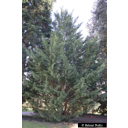Wissenswertes zum Taxon (Art, Unterart, Varietät...)
Cupressus × leylandii A. B. Jacks. & Dallim.
Cupressaceae
- Zypressengewächse (APG IV modified (including gymnosperms))Bastardzypresse, Leylandzypresse
Taxonkonzept: The Plant List (2014), version 1.1
Verbreitung: Kulturform
× Cuprocyparis leylandii (Dallim & A. B. Jacks.) Farjon - Accepted: × Cuprocyparis leylandii (Dallim & A. B. Jacks.) Farjon bei Zander 2008; Familie: Cupressaceae (APG III)× Cuprocyparis leylandii (Dallim & A. B. Jacks.) Farjon - Synonym: Cupressus × leylandii A. B. Jacks. & Dallim. bei The Plant List (2014), version 1.1; Familie: Cupressaceae (APG III)Cupressus × leylandii A. B. Jacks. & Dallim. - unresolved: Cupressus × leylandii A. B. Jacks. & Dallim. bei The Plant List (2014), version 1.1; Familie: Cupressaceae (APG III)× Cupressocyparis leylandii (A. B. Jacks. & Dallim.) Dallim. - Accepted: × Cupressocyparis leylandii (A. B. Jacks. & Dallim.) Dallim. bei not specified; Familie: Cupressaceae (APG IV modified (including gymnosperms))× Cupressocyparis leylandii (A. B. Jacks. & Dallim.) Dallim. - Synonym: Cupressus × leylandii A. B. Jacks. & Dallim. bei The Plant List (2014), version 1.1; Familie: Cupressaceae (APG IV modified (including gymnosperms))
Erhardt, W., Götz, E., Bödeker, N. & Seybold, S. (2008): Der große Zander. Enzyklopädie der Pflanzennamen. Band 2. Arten und Sorten. Eugen Ulmer KG, Stuttgart (Hohenheim), 18. Aufl., 2103 S.; The International Plant Names Index (2009). Published on the Internet http://www.ipni.org; Courtesy to IPNI, 2009. Exported from IPNI at date: 2009-09-22 20:17:51;
Diese Webseite verwendet Google Maps, um Karten und Standorte von Pflanzen in den Hohenheimer Gärten anzuzeigen. Dadurch werden unter Umständen Daten an Google weitergeleitet, was mit einer Verarbeitung Ihrer personenbezogenen Daten verbunden sein kann. Die Datenschutzerklärung von Google finden Sie hier: Datenschutzerklärung von Google
| Geschlecht | Standort | Akzessions-Nr. | Pflanzjahr | Spende | IPEN | Lat. | Long. |
|---|---|---|---|---|---|---|---|
| Parzelle P | EG-P-081-21937 | 1982 | XX-0-HOH-EG-P-081-21937 | 48,7075403488 | 9,2102304756 | ||
| Parzelle C | SP-CB-003-15635 | XX-0-HOH-SP-CB-003-15635 | 48,7115535612 | 9,2127038919 |

